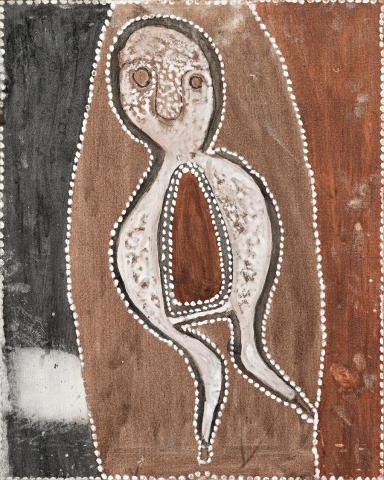OWL, 1988
ROVER THOMAS (JOOLAMA)
natural earth pigments on canvas-board
50.5 x 40.5 cm
Mary Macha, Perth
Private collection
Sotheby's, Sydney, 25 November 2007, lot 46
Private collection, Adelaide
The Story of Owl (Dumbiny), 1988, collection of the Art Gallery of South Australia, Adelaide, illus. in Cumpston, N., and Patton, B., Desert Country: Contemporary Aboriginal Painting, Art Gallery of South Australia, Adelaide, 2010, pp. 90–91
Goolgool the Owl with Four Young, 1988, collection of the Art Gallery of Western Australia, Perth, illus. in O'Ferrall, M.A., On the Edge: Five Contemporary Aboriginal Artists: Bede Tungutalum, Rover Thomas, Mandjuwi, Milpurrurru, Trevor Nickolls, The Art Gallery of Western Australia, Perth, 1989, p. 36, pl. 14
Grugrugi: Owl, 1989, Holmes à Court Collection, Perth, illus. in Brody, A.M., et al, Contemporary Aboriginal Art: The Robert Holmes à Court Collection, Heytesbury Holdings Ltd, Perth, 1990, p. 23, pl. 1, and illus. in Carrigan, B., Rover Thomas: I Want to Paint, Holmes à Court Gallery, Perth, 2003, cat. 20
Story of Owl, 1988, collection of the Art Gallery of Western Australia, Perth, illus. in Eather, M., and Hall, M., Balance 1990: Views, Visions, Influences, Queensland Art Gallery, Brisbane, 1990, p. 18
The significance of Rover Thomas's art lies in his deep-rooted knowledge of the past, in his role as a custodian of the Kurirr Kurirr ceremony and in his highly idiosyncratic style. The past and the present converge in Thomas's enigmatic paintings that explore the history of the land and the ancestral tales.'Thomas elaborated on the pictorial conventions of the region to articulate a highly personal vision. He introduced an interplay between broad areas of natural colour, unfaltering line, bold forms, and uncompromising composition.'1 Mapping out the land in strong earthy tones and abstract shapes, Thomas carefully balances the landscape and the narrative in perfect harmony. He would often utilise two modes of perspective, an aerial view of the roads and the countryside and a profile view of landscape features and figures as demonstrated in Owl, contrasting the figure against the block colours. One of the few subjects that the artist rendered in a naturalistic fashion, the profile of the owl is delineated by daubs of white paint as is the background, which is separated into three colours. This stippling which has become typical of Thomas's celebrated works, references his birthplace in the desert and the art of that region.
Known by a number of names, the Ancestral Owl is a central figure in Kimberley cosmology and is responsible for a number of ceremonial practices. The Owl has a connection to the Wanjina beings found predominantly in western and northern Kimberley, but not so much in the east, where the artist lived and painted. Thomas is therefore expressing a link between his original desert heritage and that of the east Kimberley, within the milieu of general Kimberley cosmology. Although the artist reveals some information to the uninitiated, the esoteric information that is held sacred to him and his people is concealed from the public and layered underneath the common visual narrative. There is a haunting complexity that is disguised by the minimalist composition. Thomas's connection to the land and as a custodian of important Dreamings reverberates throughout his oeuvre, as each work is an ode to the land, his people and their history both physical and spiritual.
1. Caruana, W., Aboriginal Art, Thames and Hudson, New York, 1993, p. 177
CASSI YOUNG
